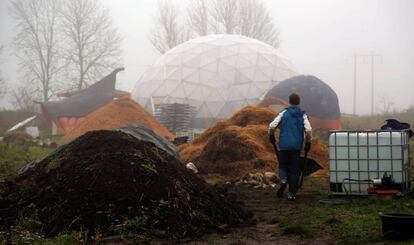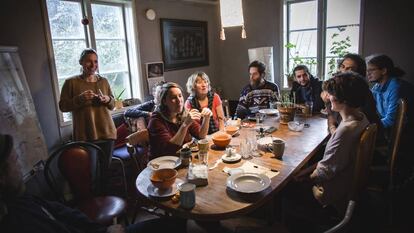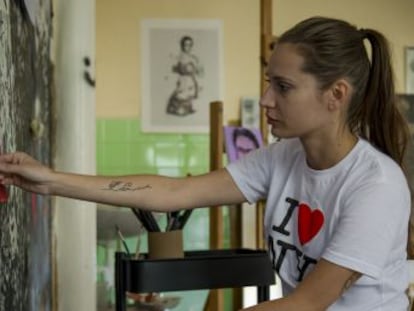Suderbyn: an ecosocial experiment in the middle of the Baltic Sea
Innovative villages like this one on the Swedish island of Gotland are leading by example in the effort to repopulate rural areas in a sustainable way. There are sister communities in several parts of Spain

The plumbers are coming. One might be tempted to simply leave them to it. But that’s not the way things work in Suderbyn. “I like to hang out with them, to watch and learn,” says Sergii Lutchenko, 29, who lives in this ecovillage located on the Swedish island of Gotland, the largest in the Baltic Sea.
Sergii, who was born in Ukraine, is an earnest man: he speaks deliberately, listens carefully, and does not seem to appreciate nonsense. It is eight o’clock on a cold morning, but not a frosty one. The plumbers’ visit is one of the latest items on the agenda as this small community of 20 people gathers together for breakfast. Nearly everything that happens in this ecovillage is up for discussion, and there is a particular focus on discussing how everyone is feeling.
That’s what Suderbyn is all about: a social, ecological, agricultural, and experimental project. It is made up of people who want to live close to nature, to learn from the land, to minimize their environmental footprint, and to learn from themselves and from the group. And to be self-sufficient, which is why it makes sense to watch the plumbers at work. But not everything is ideal.
I wasn’t happy, I was asking myself a lot of questions, and when I saw an opportunity to live in a community that was more in line with my own values, I jumped on it
Antonio García, from Seville
Suderbyn is a drop of water in a growing sea of ecovillages scattered across Europe; social projects trying to fight the rural exodus. According to Eurostat, 19.2% of the population of the Europe of the 28 lives in predominantly rural areas, while 44.8% is concentrated in cities and the rest somewhere in between.
But in Sweden’s case, the trend is more exaggerated: in a large country with a population of just 10 million, only 13% of people live in rural areas. Add to this the harsh climate and scarcity of urban areas, and it spells trouble on several fronts: infrastructure, communication, services...In Spain, by comparison, where there is also a clear exodus to the cities, 23% of the population still lives in rural areas, fully 10 percentage points more than in Sweden.
“I’m making lentils with pumpkin, potatoes and onions from our garden,” explains Antonio García, a 29-year-old native of Spain who was living in Seville before moving here. “I wasn’t happy, I was asking myself a lot of questions, and when I saw an opportunity to live in a community that was more in line with my own values, I jumped on it.”
García arrived in Suderbyn before the summer with his three-year-old daughter thanks to a EU volunteer program. The child spends two or three months with him, and a similar period of time with her mother back in Seville. “You can study how humankind can move in one direction or another,” he says, holding a spade. “You can look at life differently, not always with the same rules and norms, through a different lens. And this is a good place to learn and put it into practice.”
That’s not a bad summary of what the Swedish couple Ingrid Gustafsson and Robert Hall were trying to achieve when they founded the ecovillage of Suderbyn a decade ago already. They wanted to be part of just such a project, to lead a lifestyle that would be economically and environmentally sustainable. They travelled across Panama but remained unconvinced. Ultimately, they decided to set up a cooperative, buy some land with help from the bank, and get started.

They are the parents of this project in many ways. Robert Hall is also a leading reference for ecovillage communities around the world. They say that during one of his trips, some of the residents set up a sauna for him as a present, something right out of J. R. R. Tolkien. The bad part was that they didn’t have a license to use it.
On June 1, the European Commission presented legislative proposals to reform the Common Agricultural Policy (CAP), one of the initiatives for greater European cohesion. The reforms comprise nine main objectives for the 2021-2027 period, and two of them fit right in with the spirit of Suderbyn: creating “vibrant rural areas” and “supporting generational renewal.” In Spain, 40% of recipients of CAP funds are over 65 years old, while under-25 beneficiaries make up less than 0.55% of the total.
Antoine Arquié was born in France 26 years ago. He is the only one of the community residents who pays no rent – one of the sources of income for the cooperative, together with a handful of grants – because of his contribution working the land. Just like the Spaniard Antonio, Antoine first came here to do volunteer work, and ended up staying.
In the logic of conventional agriculture, when you use a tractor to grow potatoes, you are not working with nature but against it
Antoine Arquié, from France
Standing next to the greenhouse, which has been named Pepita and where residents are experimenting with vertical agriculture, Antoine explains about the concept of permaculture: “In the logic of conventional agriculture, when you use a tractor to grow potatoes, you are not working with nature but against it, viewing it as something weak that needs to be improved. With permaculture, nature is what it is and that’s how it works, it’s a wonderful thing that will help us cultivate the land.”
On the island of Gotland, the sun is not a regular presence, unlike the wind. So crops are grown in beds shaped into a horseshoe so the sun and the heat will accumulate inside the beds while part of the wind is deflected. One of the basic principles of permaculture is observing how the elements work and interacting with them.
Synergies with Spain
Just a few meters from this horseshoe, there is a wind turbine. The idea came for an ecovillage in Spain: Los Portales, in Seville province, whose residents have a very good relationship with Suderbyn. In fact, Suderbyn founder Robert Hall recently paid a visit to Los Portales and to the sister communities of Lakabe and Arterra in the northern Spanish region of Navarre.
The Spanish community of Los Portales started out in 1984 and there are now 40 residents. Kevin Lluch, a 59-year-old psychologist, is one of the veterans. “The idea of a community as a solution is basic for synergies between the ecovillages,” he says in a telephone conversation. “With individualism as a starting point, there are dynamics that can be changed.”
The residents of Suderbyn who were interviewed for this story, which was sponsored by the European Parliament, talk about the community as a pillar to life in the countryside. “I love living this way,” says Leila Alengry, a 25-year-old from Belgium. “You are surrounded by people, and even though that can affect your mood, and we can break down, we are still a community, we work together and we continue to push forward.”
Driving along the road that runs parallel to the coastline in Gotland, a futuristic-looking greenhouse stands out. Its name honors its shape: the Dome. Inside this dome, Sergii is standing in the middle of piles of wooden beams and heavy machinery, working on a biogas digester to recycle nutrients and create a closed-loop system for small-scale food and energy production.
It works. Or at least it did when it was tested. Just like community living, sometimes things fail. The residents admit that they are not professionals, that they are having to learn everything from scratch in order to be more “efficient,” and to keep observing the plumbers to become more self-sufficient, so that they may remain in their rural community forever.
English version by Susana Urra.


